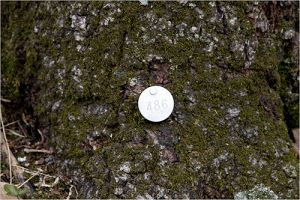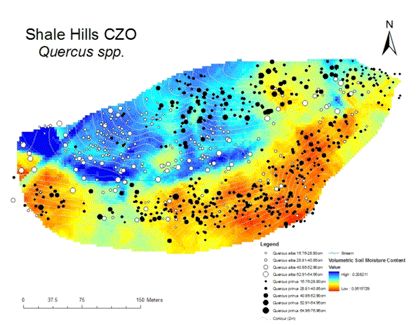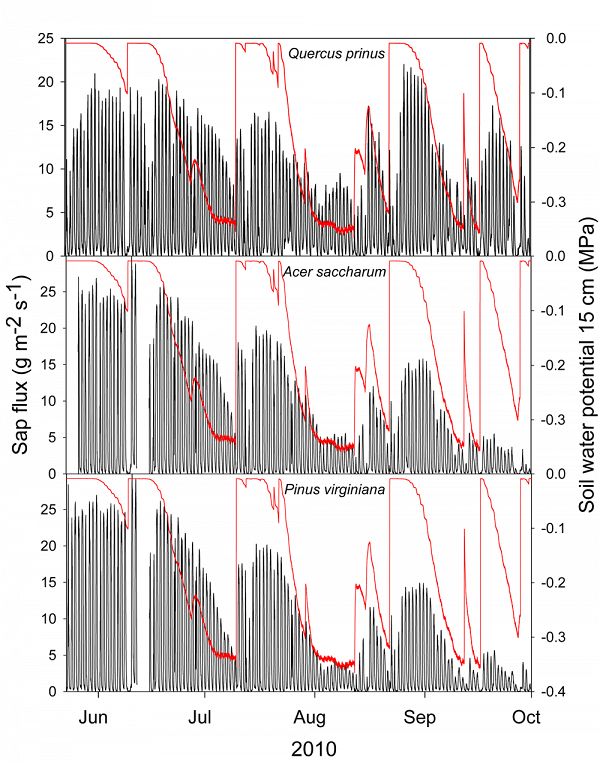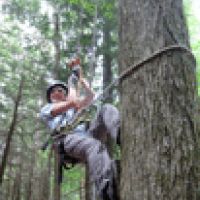Ecology Research Group
Ecological studies at the Shale Hills Observatory include patterns of tree water use across the water shed, and how water availability may influence trees at the physiological, community and evolutionary time scales.
Image: Initial field campaign was to survey all canopy trees greater than 8” diameter at breast height (DBH).
This group is tagged with:
-
Ecological studies at the Shale Hills Observatory include patterns of tree water use across the water shed, and how water availability may influence trees at the physiological, community and evolutionary time scales. Measurements include:
• Mapping of tree species distribution, sapwood area and leaf area index
• Transpiration by sap flux
• Tree hydraulic parameters for conducting water and tolerating water stress
• Sources of water uptake using natural abundance of 18O and 2HFrom this work we hope to improve hydraulic models and our understanding of how water availability shapes the ecology of temperate forest trees.Figure 1. Distribution map for Oak species (Quercus spp.) at the Shale Hills Critical Zone Observatory. Notice the species occur preferentially on wetter or drier soils. Base map of soil moisture (blue = wetter) is after a period of limited rainfall in August 2005.
We characterized the woody vegetation in the watershed by surveying all canopy trees greater than 8” diameter at breast height (DBH). From this data we gained information about the presence, distribution, and dominance of species within the watershed. These data are being used to better understand how water availability may influence the ecology of tree species as well as permit scaling of individual estimates of tree transpiration (Figure 1).
Sap flow sensors (heat dissipation probes) have been installed at multiple locations in the watershed in multiple tree species. Data are being continuously logged and transmitted to the web. Trees of different vascular anatomy (ring-porous vessels, diffuse porous vessels, trachieds only - coniferous) seem to have very different responses to wetting and drying events (Figure 2).
Small branch samples have been collected to measure specific conductivity, capacitance, and xylem vulnerability. These parameters make it possible to characterize the hydraulic architecture of the tree and to determine which species make more or less conservative use of water. Six species within the three dominant genera of the watershed were sampled at four different sites. By sampling all species at both wet and dry sites, environmental variation is reduced and we are able to begin to differentiate between genetic adaptation by a species and an individual’s plasticity.Figure 2. Seasonal courses of sap flow (black lines) and soil water potential (red lines) in tree species representing three contrasting wood types: ring-porous (Quercus prinus), diffuse-porous (Acer saccharum) and coniferous (Pinus virginiana). While all species exhibit reduced sap flux with reductions in soil water availability, the ring-porous oak is much less adversely affected in recovering sap flux with rewetting later in the season. In contrast, the other two species, show a steady decline in their transpiration rates across the growing season with successive soil drying/rewetting cycles.
When trees take up water from the soil, the water maintains the same concentration of 18O and 2H isotopes while it is transported through the tree. By extracting the xylem water from small branches in the canopy, it is possible to determine the isotopic signature of the water taken from the soil. This signature is then compared with the signatures of surface-shallow soil water and deeper ground water. Because each source has a unique signature, we can determine which water source the tree is relying on by how similar the tree’s signature is to a source’s signature.
Contact: David Eissenstat (PI)
Figure 2. Seasonal courses of sap flow (black lines) and soil water potential (red lines) in tree species representing three contrasting wood types: ring-porous (Quercus prinus), diffuse-porous (Acer saccharum) and coniferous (Pinus virginiana). While all species exhibit reduced sap flux with reductions in soil water availability, the ring-porous oak is much less adversely affected in recovering sap flux with rewetting later in the season. In contrast, the other two species, show a steady decline in their transpiration rates across the growing season with successive soil drying/rewetting cycles.
Figure 1. Distribution map for Oak species (Quercus spp.) at the Shale Hills Critical Zone Observatory. Notice the species occur preferentially on wetter or drier soils. Base map of soil moisture (blue = wetter) is after a period of limited rainfall in August 2005.
-
Contacts
-
Shale Hills, INVESTIGATOR
9 People
.(JavaScript must be enabled to view this email address), 607/255-9354
Cornell
Biogeochemical processes
.(JavaScript must be enabled to view this email address)
Climate change, ecosystems ecology, physiology of fruit crops, root biology and ecology.
INVESTIGATOR, Visiting/Affiliate
.(JavaScript must be enabled to view this email address)
CZ development and the movement of contaminants.
.(JavaScript must be enabled to view this email address)
Vegetation dynamics; global change ecology; interactions among vegetation, climate/human land use
GRAD STUDENT
.(JavaScript must be enabled to view this email address)
Biology - Ecology
GRAD STUDENT
.(JavaScript must be enabled to view this email address)
Vegetation - Bedrock interactions
INVESTIGATOR, COLLABORATOR
.(JavaScript must be enabled to view this email address)
Ecology and Evolutionary Biology, and Plant Biology
GRAD STUDENT
.(JavaScript must be enabled to view this email address)
Ecology
.(JavaScript must be enabled to view this email address)
Hydrological connectivity between stream and aquatic areas of the riparian zone
Alumni-Former
GRAD STUDENT
.(JavaScript must be enabled to view this email address)
Tree Physiology
INVESTIGATOR, PostDoc
.(JavaScript must be enabled to view this email address)
Quantitative plant ecology
GRAD STUDENT
Forest and wildlife ecology, carbon pool fluxes in response to climate change
GRAD STUDENT
.(JavaScript must be enabled to view this email address)
Horticulture
-
-
Featured Publications
2011
Hydraulic patterns and safety margins, from stem to stomata, in three eastern US tree species. Johnson, D. M., McCulloh, K. A., Meinzer, F. C., Woodruff, D. R., and Eissenstat, D. M. (2011): Tree Physiology 31:659-68
Explore Further















